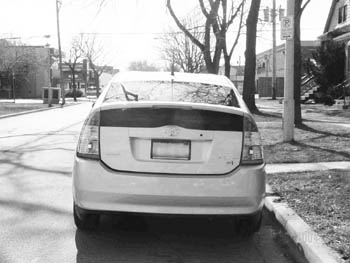![[Metroactive Features]](/gifs/feat468.gif)
[ Features Index | Santa Cruz | Metroactive Home | Archives ]
Acronym Hell
Partial Zero Emissions Vehicle--what does that involve? What's a 'partial zero'?
By Novella Carpenter
There's been something niggling at the back of my mind lately. I don't know what the acronym PZEV means. Well, I know what it means--Partial Zero Emissions Vehicle--but what does that involve? What's a "partial zero"?
While attending a car show, I pledged to find the answer. I approached the Ford area, a carpeted and gleaming automobile haven, and asked one of the women wearing black suits, "What is PZEV?" I pointed at one of the posters, trumpeting the Ford Focus and its PZEV feature. "I can't talk to reporters," she said and redirected me to a man behind the Ford counter.
"I wanted to know more about the PZEV cars," I asked. "What are the emission rates? And how do they work?"
"I do not know exactly what the emission rates are." The curly-haired fella grinned one of those fake auto-show smiles. "I do know that under the California Air Resources Board [CARB] guidelines, it does qualify as a PZEV."
"So, zero emissions out of the tailpipe?"
"Right."
"So no carbon dioxide released at all?"
"Well, there is, but as CARB rates those numbers--I'm sorry I don't know those numbers--it qualifies. Mr. Bill is very keen on the environment." Curly man gave me an ah shucks wave. Foiled again. Mr. Bill?
If all the hype is correct, then we've got a clean-burning car that doesn't cost as much as a hybrid. There are already thousands of these cars. In 2003, Ford released its PZEV Focus with little fanfare. According to The New York Times, the Focus featured a 2.3-liter, four-cylinder Duratec engine that produces one-10th of the various smog-forming emissions of the conventional Focus. That translates to "only" 1 pound of emissions after 15,000 miles (when using low-sulfur gasoline), compared to 10 pounds for non-PZEV cars. So far so good. Just how did Ford (and others: BMW, Nissan, Honda, Subaru) do this? Mostly by making simple modifications to the existing engine, like adding a quick-heating catalytic converter that reduces pollution. The other method to cut emissions was to add a steel gas tank and fuel lines, and include a system that eliminates vapors escaping from the tank.
It was CARB that instigated these changes, directing car companies to make 6 percent of their cars PZEVs. When I talked to CARB spokeswoman Gennet Paauwe, she let me know that it's true the PZEVs do reduce smog-forming emissions, but there is one well-known particle that isn't part of the PZEV plan: carbon dioxide. Our friend CO2 has been shown to be a major greenhouse gas that causes global warming. California is planning to regulate carbon dioxide starting in 2009, but for now, PZEVs don't address CO2 emissions. She also mentioned that there are additional emissions-level categories, like SULEV, ZEV and AT-PZEV. Oh no! More acronyms! Just in case this comes up again, here's a little acronym primer:
[ Santa Cruz | Metroactive Central | Archives ]
Copyright © Metro Publishing Inc. Maintained by Boulevards New Media.
For more information about Santa Cruz, visit santacruz.com.
![]()

Rev
Email [email protected].
From the January 26-February 2, 2005 issue of Metro Santa Cruz.